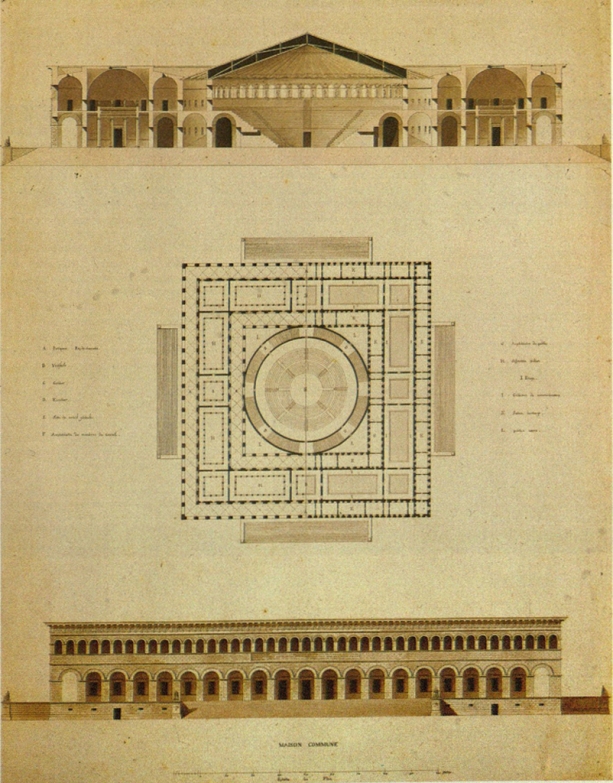DURAND IN DEUTSCHLAND: FORMAL ECONOMY, FINANCIAL ARGUMENTATION, AND THE SCARCITY OF MEANS IN GERMAN ARCHITECTURE FROM 1799 TO 1848
Marc Britz
As architectural educator, prominent French theorist Jean-Nicolas-Louis Durand (1760-1834) had a considerable influence on the German architectural production throughout the first half of the 19th century. Attracted by the French architect’s modern teaching method, a generation of young German architects became guest students in his course on architecture at the École Polytechnique in Paris and interns in Durand’s private atelier. In contrast to the rather unstructured education in their homelands, Durand provided the Germans with a codified system of architectural composition and a radically concise conception of the architectural object. For Durand, architecture was referential only to the history of its own solutions and thus divisible into genres of autonomous artefacts in the service of common public welfare. Durand propagated the idea that the prime objective of every architectural design lay in the achievement of the most fitting and the most economic disposition of a conventionally defined architectural repertoire within the ideal constraints of a building’s given genre. German students like Gottlob Georg Barth (1777-1848), Clemens Wenzeslaus Coudray (1775-1845), Johann Friedrich Christian Hess (1785-1845), Leo von Klenze (1784-1845), Peter Cremer (1785-1863), and Adolph Anton von Vagedes (1777-1842) continued to practice along the lines of Durand’s teachings throughout their subsequent careers in the many capitals of the various German states. As court architects or state-employed architectural inspectors, they were forced to adjust and fine-tune Durand’s abstract universal theory of architectural disposition to the quite often hostile contingencies of their commissions. Guided by the will to stick to Durand’s generally classicizing architectural idiom and faced with the primary task of erecting public and private buildings under the pressure of material and financial scarcity, these site-specific adjustments took on many forms. Given these circumstances, Durand had involuntarily set the agenda for the Germans to follow with an ingenious conflation of architectural form, budget, and beauty: “All of the architect’s talent comes down to the solution of two problems: (1) in the case of private buildings, how to make the building as fit for its purpose as possible for a given sum; (2) in the case of public buildings, where fitness must be assumed, how to build at the least possible expense. It will thus be seen that in architecture there is no incompatibility, and no mere compatibility, between beauty and economy: for economy is one of the principle causes of beauty.”2 Durand’s discovery that architectural form could be supported by a financial argument resonated in the many ways in which the German architects tried to match their own sense of beauty to their patrons’ budgets. From the formulation and implementation of administrative guidelines for urban and rural planning to the reorganization of architectural education, including the erection of institutional buildings, and the renewal of architectural theory, Durand’s followers were forced to set his lucid theory of architectural fitness and economy to work in the muddled complexity of a nation struggling to emerge from provinciality.
This dissertation will examine Jean-Nicolas-Louis Durand’s architectural theory in correspondence to the architectural production of his former German students by analyzing the multiple compositional tactics and building techniques in which the German architects followed Durand’s economical dictum throughout their careers. The dissertation’s main focus will be on the notion of financial argumentation as a potentially subversive strategy to realize architectural objects according to specific formal preferences. Apart from highlighting Durand’s influence on Germany’s early modern architecture, the dissertation will thus describe the more practical problems related to the implementation of architectural projects against the financial and material scarcity in early 19th century Germany. Following the trajectory of the German disciples’ professional development and drawing from the different texts, buildings, projects, and biographies involved, the ultimate objective of the dissertation is to examine the theoretical conflation of architectural form and financial argumentation in Durand’s theory within the material constraints of a number of concrete examples ranging from Coudray’s failed theatre project in Weimar to Klenze’s successful museum in Munich.
2 Jean-Nicolas-Louis Durand; Précis of the Lectures on Architecture; The Getty Research Institute Publications Program, Texts and Documents; Los Angeles; 2000; p. 86


